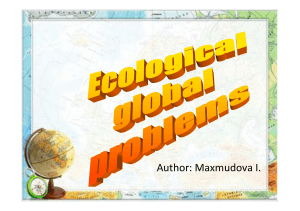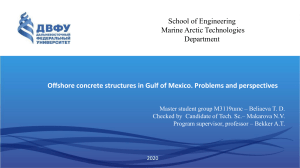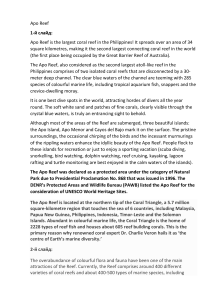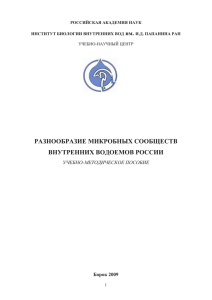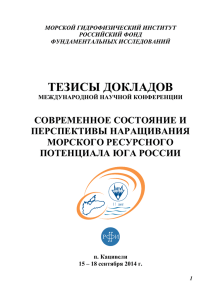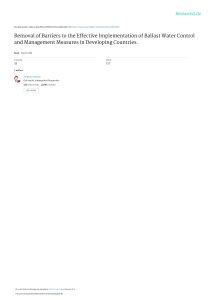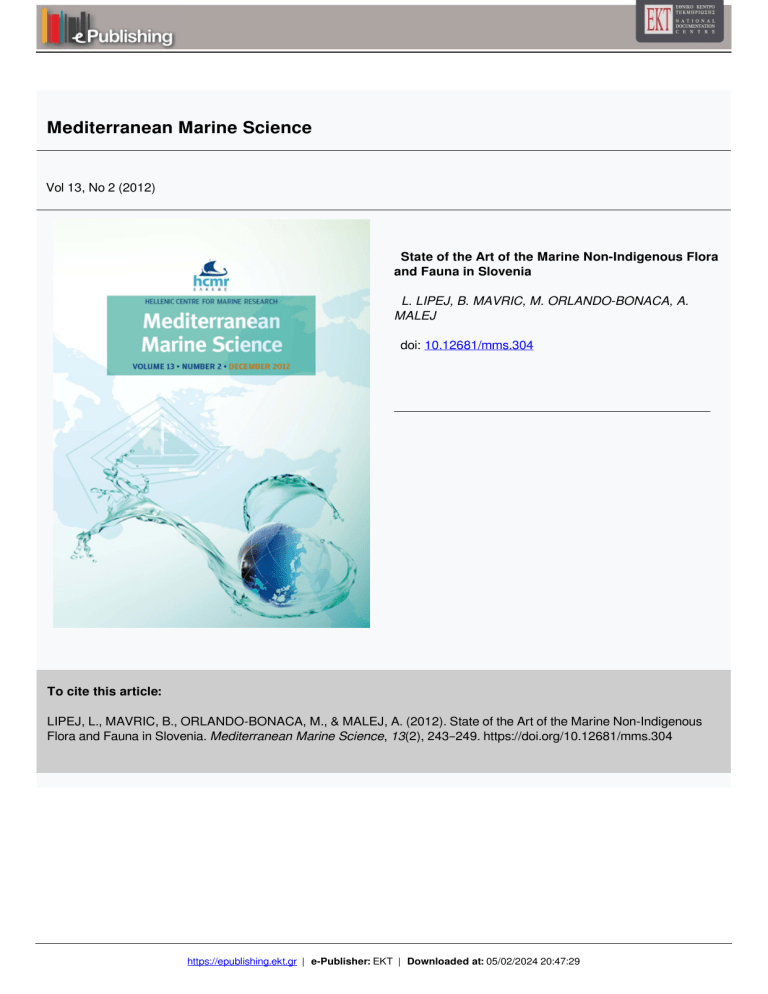
Mediterranean Marine Science Vol 13, No 2 (2012) State of the Art of the Marine Non-Indigenous Flora and Fauna in Slovenia L. LIPEJ, B. MAVRIC, M. ORLANDO-BONACA, A. MALEJ doi: 10.12681/mms.304 To cite this article: LIPEJ, L., MAVRIC, B., ORLANDO-BONACA, M., & MALEJ, A. (2012). State of the Art of the Marine Non-Indigenous Flora and Fauna in Slovenia. Mediterranean Marine Science, 13(2), 243–249. https://doi.org/10.12681/mms.304 https://epublishing.ekt.gr | e-Publisher: EKT | Downloaded at: 05/02/2024 20:47:29 Powered by TCPDF (www.tcpdf.org) Research Article Mediterranean Marine Science Indexed in WoS (Web of Science, ISI Thomson) and SCOPUS The journal is available on line at http://www.medit-mar-sc.net State of the Art of the Marine Non-Indigenous Flora and Fauna in Slovenia L. LIPEJ, B. MAVRIČ, M. ORLANDO-BONACA and A. MALEJ Marine Biology Station, National Institute of Biology, Piran, Slovenia Corresponding author: [email protected] Received: 22 June 2012; Accepted: 13 July 2012; Published on line: 10 September 2012 Abstract Authors provide the state of knowledge on marine non-indigenous species in waters off Slovenia. According to published records and authors unpublished data at least 15 non-indigenous species were up to date recorded in the Slovenian part of the Adriatic sea. Eleven species were considered as established and four species as casual. The vectors of introduction are various, comprising Lessepsian migration, mariculture and shipping. The majority of non-indigenous taxa were recorded in the mediolittoral belt and coastal lagoons. The low number of non-indigenous species so far recorded in the Slovenian part of the Adriatic sea could be explained by various factors. Among them, the most reasonable are the lack of scientific attention, the small proportion of Slovenian Sea and low winter temperatures, which represents a physiological barrier for the survival of newcomers. The number of recorded species is far from being satisfactory. Therefore, we expect that the list of non-indigenous species will be enlarged in the nearby future. Keywords: Non-indigenous species, Mediterranean Sea, Slovenia, bioinvasion. Introduction Materials and Methods The Gulf of Trieste is considered to be one among the very first studied marine areas, with the first researches originating already as far as in 1750 (Casellato, 2008). Despite this centennial tradition in marine research, nonindigenous species in the area deserved less attention within published papers in comparison with neighbouring areas. That is especially true for the Slovenian part of the Gulf of Trieste, where only few papers exists on the non-indigenous flora and fauna. The published works deal mainly with the first records of certain species (Lipej et al., 2008; Shiganova & Malej, 2009), on occasional surveys on flora and fauna (Orlando-Bonaca, 2001, 2010) or biotic globalisation as a whole (Lipej et al., 2009), while records of alien mollusca from the whole Gulf of Trieste area were recently reviewed (see Crocetta & Turolla, 2011; Crocetta, 2011). Up to date, no recent report exists on the current status of non-indigenous species in the Slovenian part of the Gulf of Trieste. Consequently, this paper attempts to bring together all available data on non-indigenous species in the area. Since the presented records were mainly occasionally collected, our understanding and interpretation of the impact of allochthonous organisms on the native biodiversity is more or less speculative. The study area Medit. Mar. Sci., 13/2, 2012, 243-249 The Gulf of Trieste is the northernmost part of both the Adriatic and the Mediterranean seas. It extends from Cape Savudrija (Croatia) to Grado (Italy) and includes the entire Slovenian coastal sea. The area is characterized by the biggest tidal differences and the lowest winter temperatures in the Mediterranean Sea. During summer months a typical thermal stratification of the water column develops, due to surface heating and fresh water inflow (Boicourt et al., 1999). In the winter period the water column is characterized by considerable vertical homogeneity, due to autumnal cooling and wind mixing (Mozetič et al., 1998). The Slovenian coastal sea covers the southern part of the Gulf of Trieste (Fig. 1). It is a shallow semi-enclosed gulf with a maximum depth of ca. 33 m in waters off Piran. Its coastline is approximately 46.7 km long. The Slovenian coastal area is affected by freshwater inflows and local sources of pollution, like intensive farming, sewage outfalls, and mariculture (Francé & Mozetič, 2006; Mozetič et al., 2008; Grego et al., 2009). 243 reported by Battelli (2000). Moreover, in summer 2008 the tetrasporophyte of A. armata was collected on limestone breakwater boulders of the Marina Izola, and some more thalli were found at Cape Ronek on a sandstone terrace (Orlando-Bonaca, 2010). The Atlas of Exotic Macrophytes in the Mediterranean Sea (CIESM, 2009) defines the species as “infrequent” for the Adriatic Sea. Fig. 1: Slovenian part of the Adriatic Sea. Methods This paper comprises all available information about marine non-indigenous species in Slovenia. It was compiled from a variety of sources, ranging from published works in scientific literature, papers in local natural history journals, institutions reports, Bachelor and master’s thesis, websites and occasional (not yet published) data. The establishment status was assigned to all nonindigenous species. Any species documented by at least three reliable records was considered as established (E), according to suggestions of Gofas & Zenetos (2003). Species reported less than in three reliable cases were considered as casual (C). Certain species were rejected as non-indigenous species (R), since new knowledge demonstrated that they should not be considered as nonindigenous species. Bonnemaisonia hamifera Hariot, 1891 The filamentous tetrasporophyte Trailliella, “pink cotton wool” phase of the red alga Bonnemaisonia hamifera, was found in shallow Slovenian waters in 1995 (Orlando-Bonaca, 2001). The species was firstly reported for the Gulf of Trieste in 1978 (Giaccone, 1978) and its tetrasporophyte is reported to be commonly found in Italian waters of the Gulf of Trieste (Falace, 2000). According to some authors (e.g. Gollasch, 2006), this species was probably introduced with shellfish from Japan. The Atlas of Exotic Macrophytes in the Mediterranean Sea (CIESM, 2009) defines the species as “infrequent” for the Adriatic Sea. However, B. hamifera was never found in any macroalgal sample collected by the Marine Biology Station. Therefore, at the moment is impossible to confirm the presence of this red alga in Slovenian waters. Results and Discussion Codium fragile subsp. fragile Suringar (Hariot), 1889 Syn. Codium fragile subsp. tomentosoides (van Goor) P.C. Silva, 1955 The first report of this subspecies was published by Munda (1992) and the presence of the green alga in Slovenian waters was confirmed in following years (Munda, 1993; Battelli & Vukovič, 1995; Battelli, 1996, 2000; Orlando-Bonaca, 2010). The subspecies could be considered as established in the area, since it is nowadays abundant at the Cape of the Piran. In the Italian part of the Gulf of Trieste, C. fragile subsp. fragile is commonly found in the northern area of the Gulf (Falace, 2000; Ceschia et al.; 2007). This green alga originates in the Pacific Ocean around Japan and it spread remotely either as an associated unintentional introduction attached to shellfish as oysters, attached to ships’ hulls or as spores in ballast tanks (Ribera & Boudouresque, 1995). Non-indigenous Flora Non-indigenous Fauna Asparagopsis armata Harvey, 1955 The tetrasporophyte (Falkenbergia rufolanosa phase) of the red alga Asparagopsis armata was recorded for the first time in Slovenian coastal waters and in the North Adriatic in 1991 (M. Richter, pers. comm.). The tetrasporophyte is reported to be commonly found in Italian waters of the Gulf of Trieste (Falace, 2000). The species originates from Australia and New Zealand and it was introduced to the Mediterranean Sea unintentionally with oysters (Ribera & Boudouresque, 1995). The presence of the alga in Slovenian coastal waters was later Mnemiopsis leidyi A. Agassiz, 1865 A swarm of the ctenophoran M. leidyi was recorded by Shiganova & Malej (2009) in the Gulf of Trieste in October 2005. This was the very first record of M. leidyi in the Adriatic Sea. After that, the species was not reported again neither in the Gulf of Trieste nor in other areas of the Adriatic Sea. 244 Beroe ovata sensu Mayer, 1912 During the same study, Shiganova & Malej (2009) found some ctenophoran specimens which were deMedit. Mar. Sci., 13/2, 2012, 243-249 termined as Beroe ovata sensu Mayer, 1912, a species which is normally occurring along the northeastern and southeastern American coasts and was found also in the Black Sea (Shiganova et al., 2000). This species was remarkably different from the native B. ovata sensu Chun, 1880. It should be probably considered as not (yet) established in the Gulf of Trieste. Balanus trigonus Darwin, 1854 The first record of the cirriped Balanus trigonus was reported by Mavrič et al. (2010) in 2005 from the Bay of Koper. Afterwards, the species was found at many stations in the upper and lower mediolittoral horizonts at different sampling stations along the Slovenian coast in 2008 and 2009. Bursatella leachii (Blainville, 1817) In the Gulf of Trieste this species already appeared in the eighties of the last century (Jaklin & Vio, 1989). In Slovenian waters it was firstly reported in 2001, when it was reported in front of the Marine Biology Station (Lipej et al., 2008a). Nowadays, the species should be considered as an established one, since it was observed, also in high numbers, in many localities (e.g. see Lipej et al., 2008a; Turk & Furlan, 2011). In October 2007, 2009, 2010 and 2011, high densities of B. leachii were recorded, with a maximum value of 50 ind/m2 (Lipej et al., 2008a). It is found mainly in shallow waters (below 2 m of depth) in rather devastated environments, such as harbours, enclosed shallow bays and coastal wetlands. Rapana venosa (Valenciennes, 1846) There are many records of Rapana venosa in infralittoral habitats of Slovenian waters (De Min & Vio, 1997). The species is present in the Gulf of Trieste probably already before 1983 (Crocetta, 2011). In the northern Adriatic Sea the first record originated from off RavennaCattolica area in 1973 (Ghisotti, 1974). Anadara kagoshimensis (Tokunaga, 1906) According to Huber (2010) Mediterranean records of Anadara inaequivalvis (Bruguière, 1789) are to be referred to A. kagoshimensis. De Min & Vio (1997) recorded this species in many localities on sandy bottoms. Recently, the species was recorded in many stations of the Koper and Piran bays, during the monitoring sampling of soft bottom macrozoobenthos. Anadara transversa (Say, 1822) The first Adriatic record of Anadara transversa originated from Venice (see Mizzan, 2002). Crocetta (2011) mentioned the finding of this species for Piran and for the Natural Monument Debeli rtič. Indeed, during our recent samplings of soft bottom macrozoobenthos, two specimens were recorded, one from the Bay of Piran and the second from the Natural monument Debeli rtič. Medit. Mar. Sci., 13/2, 2012, 243-249 Crassostrea gigas (Thunberg, 1793) According to De Min & Vio (1998), the first specimens of Pacific oyster were reported for the northern Adriatic Sea already in 1964 and in waters off Slovenia in 1971. Crocetta (2011) reported C. gigas from all over the Gulf of Trieste. Indeed, the Pacific oyster is nowadays distributed along the whole Slovenian coast, mainly in the lower mediolittoral belt (De Min & Vio, 1997) and especially in canals of salinas. We recently found this species also in the coastal wetland of the Škocjan Inlet. Venerupis philippinarum (A. Adams & Reeve, 1850) The Manila clam was intentionally introduced into the Grado Lagoon in 1983 and from there spread also in other areas of the Gulf of Trieste (Zentilin et al., 1997; Mizzan, 1999; Crocetta, 2011). In Slovenia, the Manila clam was first introduced in the abandoned salt basin close to the estuary of the Dragonja river, already in 1993 (Lipej, 1994). Nowadays, the species, which generally inhabits the euryrherm and euryhaline biocoenosis, is present also in the Škocjan Inlet, a predominantly brackish coastal wetland. However, its density is rather low. Arcuatula senhousia (Benson in Cantor, 1842) This species was first reported for Slovenian waters by Mavrič et al. (2010) (see Crocetta, 2011 for further discussion on the topic) on the basis of few specimens found in 2005 on a sedimentary bottom. Nowadays A. senhousia could be found in great density in very shallow areas of the Škocjan Inlet, close to the city of Koper. According to Zenetos et al., 2010) the species should be considered as an invasive species in the Mediterranean. Ficopomatus enigmaticus (Fauvel, 1923) First recorded in the Venetian lagoons in 1934 (Mizzan, 1999), the sedentary polychaete Ficopomatomus enigmaticus was firstly recorded in the Sečovlje Salina in 1994. It seems to originate in the Southwest Pacific and it is not clear whether its vector of introduction has been ballast waters or ship’s hulls. Nowadays it is an established species in Slovenia, since it is rather common in coastal wetlands, especially in the Škocjan Inlet, where it forms organogenic formations. Terapon theraps Cuvier, 1829 On 10th August 2007 a specimen of Terapon theraps, 109 mm in total length, was captured by a trawler 1.5 nautical miles northeast of Piran (Lipej et al., 2008b). The specimen was alive deposited in the Piran Aquarium, where it was kept for almost a year. That record constitutes the first one for the whole Mediterranean sea. Taxonomically and ecologically unclear status Some already reported species were not taken into consideration for the present check-list. A rare or rather less known dinoflagellate Ceratoperidinium yeye 245 was found in Slovenian waters in July 2003 (Francé & Mozetič, 2008). Zenetos et al. (2005) already listed this species in the table of non-indigenous species in the Mediterranean Sea. The lack of knowledge on dinoflagellates before the opening of the Suez Canal hinders attempts to determine biogeographical origins of present Mediterranean species (sensu Gómez, 2005). The occurrence of the siphonophoran Muggiaea atlantica was reported by Miloš & Malej (2005) for the Slovenian part of the Gulf of Trieste. Authors reported that the species occurred throughout the year 2001 in the area, with the highest densities in June (84 ind/m3). This species was firstly reported for the Adriatic Sea near Dubrovnik in 1995 (Gamulin & Kršinić, 1999; Kršinić & Njire, 2001). However, Zenetos et al. (2005) excluded Muggiaea atlantica from the list, since it is considered to be a cosmopolitan neritic species, as stated by Bouillon et al. (2004). From the ecological point of view, the mosquitofish Gambusia holbrooki is considered as a freshwater fish. However, certain authors included this species in their checklists of marine alien species (for example, Paavola et al., 2005; Streftaris et al., 2005). In fact, the mosquitofish could be found in brackish or completely marine environment, as well. In Slovenian coastal waters it was up to date recorded in coastal wetlands and salinas, and it is probably established already from the thirties of the last century (Leiner et al., 1995). Doubtful records The green alga Ulva scandinavica Bliding was recorded for the first time in Slovenian coastal waters and in the Adriatic Sea in 1998 (Battelli & Tan, 1998). Before that, the species was recorded in the Mediterranean Sea only on the West and South coast of Italy (Battelli & Tan, 1998). The presence of the species was not reconfirmed for Slovenian coastal waters. Moreover, it has never again been reported for the Mediterranean Sea and according to AlgaeBase (Guiry & Guiry, 2012) and WoRMS (Appeltans et al., 2012) registers, this name is currently regarded as a taxonomic synonym of Ulva rigida C. Agardh. The species was already excluded from the list of non-indigenous species found in the Mediterranean Sea by Zenetos et al. (2005). Comparison with adjacent areas Eighteen non-indigenous species were up to date recorded in Slovenian waters. Among them, three species (Ceratoperidinium yeye, Muggiaea atlantica, and Gambusia holbrooki) were rejected due to various reasons. Among 15 confirmed non-indigenous species, 11 should be considered as established. Other four species are considered as casual (Table 1). However, at least in the case of two ctenophorans, we could speculate that the similarity with native species could affect the overlooking of non-indigenous taxa. In fact, M. leydyi is rather 246 similar to the native species Bolinopsis vitrea, while B. ovata closely resemble the native B. cucumis. As in other regions, the vectors of introduction are various, comprising Lessepsian migration, mariculture and shipping. Eight species were introduced via shipping, among them six are considered to be introduced in waters off Slovenia with ballast waters and two species as a fouling organisms. Five other species were introduced voluntarily or accidentaly with mariculture. Two species are Lessepsian migrants, while the mosquitofish was purposely introduced as a biocontrol organism. More than half of all non-natives are represented by mollusks, three are algae, while other taxonomical groups (ctenophorans, cnidarians, polychaets, cirripeds and fishes) are represented by a single species. There are some other non-indigenous species reported for Slovenia. Vrišer (1978) reported the presence of cirriped Megabalanus tintinnabulum (Linnaeus, 1758) on experimental plates submerged in a polluted area within the Bay of Piran. However, Relini (1980) expressed many doubts about this record (and other records in the Adriatic), since he is convinced that the species is not present in the Adriatic Sea. By studying the ballast waters in tank of 15 ships intending to discharge ballast water from their tanks into the waters off port of Koper David et al. (2007) found three non-indigenous species, the tintinnid Tintinnopsis mortenseni and copepods Acartia tonsa and Paracartia grani. T. mortenseni originated from ballast water of Porto Marghera (Venice), P. grani from Bari, and A. tonsa from Bari, Venice and Porto Marghera. The tintinnid was not yet found in Slovenian waters (Lipej, 1992). The copepod P. grani was recorded for the very first time in the Gulf of Trieste in summer months by De Olazabal et al. (2006) The discovery of three non-indigenous species species in the ballast water tanks indicates that the spreading of alien species via ballast waters from other Adriatic (and Mediterranean) areas is actually going on. The majority of non-indigenous species were firstly reported only during the last decade. All obtained numbers are rather low in comparison with adjacent areas (Trieste and Venice Gulfs), which could be explained by various reasons. The first is that the topic of non-indigenous species did not receive the proper attention and should be thus considered as poorly studied. The second reason is related to the size of the studied area, which covers only a small portion of the Gulf of Trieste and less than 50 km of coastline. The third reason could be related, to our opinion, to the fact that in the area there are only few substantially devastated environments, where non-indigenous species could settle down at first. And finally, we cannot neglect the low winter temperatures in the studied area which might have an important impact on the survival of newcomers. The great majority of recorded and reported non-indigenous species are, as expected, mollusks. However, it Medit. Mar. Sci., 13/2, 2012, 243-249 Table 1. List of the recorded non-indigenous species in waters off Slovenia and their status, origin, vector of introduction and source. Legend: Status: E – established, C – casual and R – rejected, Pathway/vector: BW –ballast waters, LM – lessepsian migration, MA –mariculture, NS – natural spreading, BC – biocontrol, FO – fouling, SC – Suez Canal. A Higher Taxa B Species C D Status Origin E Year F Pathway/ Vector Phyto-plankton Ceratoperidinium yeye R Indo-Pacific 2003 Range expansion/NS? Francé & Mozetič (2008) Algae Asparagopsis armata E Australia 1991 MA Orlando-Bonaca (2001) Algae Bonnemaissonia hamifera C Pacific ocean 1995 MA Orlando-Bonaca (2001) Algae Codium fragile subsp. fragile E Pacific ocean 1992 Shipping/BW Munda (1992) CnidariaSiphonophora Muggiaea atlantica R Atlantic ocean 2001 Range expansion/NS? Miloš & Malej (2005) Ctenophora Mnemiopsis leydyi C Black Sea 2007 Shipping/BW Shiganova & Malej (2009) Ctenophora Beroe ovata C Black Sea 2007 Shipping/BW Shiganova & Malej (2009) Crustacea Balanus trigonus E Tropical seas 2005 Shipping/FO Mavrič et al. (2010) Mollusca Bursatella leachi E Red Sea 1999 Suez Canal/ spreading Lipej et al. (2008a) Mollusca Rapana venosa E Japan 1983? Shipping/BW De Min & Vio (1998) Mollusca Venerupis philippinarum E Indo-Pacific 1993 MA Lipej (1994) Mollusca Anadara kagoshimensis E Indo-Pacific 1996 Shipping/BW De Min & Vio (1997) Mollusca Anadara transversa E Indian ocean 2003 Shipping/BW Crocetta (2011) Mollusca Crassostrea gigas E Japan ? MA De Min & Vio (1998) Mollusca Arquatula senhousia E Indo-Pacific 2005 MA Mavrič et al., (2010) Polychaeta Ficopomatomus enigmaticus E Southern hemisphere 1994 Shipping/FO Lipej et al. (2009) Fish Gambusia holbrooki R SE USA <1930 BC Leiner et al. (1995) Fish Terapon theraps C Indo-Pacific 2007 Suez Canal/? Lipej et al. (2008b) surprises that not a single decapod non-indigenous species species was recorded in waters off Slovenia. For the Venice lagoon many crustaceans were reported, mainly crabs (Decapoda) (Mizzan, 1999). The reason could be hidden in the counter-clock currents in the North Adriatic that might prevent spreading of larvae to the eastern part (Gulf of Trieste). The majority of non-indigenous species are mainly confined to the shallow littoral and infralittoral zones of the eastern Mediterranean (Katsanevakis et al., 2011). It is worth noting that in Slovenian waters many recorded non-indigenous species were found in two biocoenoses: the biocoenosis of the lower mediolittoral rock and the euryhaline and eurytherm biocoenosis. In particular, the brackish wetland Škocjan Inlet hosts at least five non-indigenous species. All reported species are considered as opportunistic species, with a broader ecological valence (Mizzan, 1999) and could tolerate great oscillations of Medit. Mar. Sci., 13/2, 2012, 243-249 G Source temperature and salinity, typical conditions of the eurytherm and euryhaline biocoenosis. Our results thus confirm that brackish waters are considered as environments where invasive species are the most successful from the aspect of colonization (Paavola et al., 2005). Due to the lack of basic knowledge on non-indigenous species in Slovenian coastal sea is, at the moment, rather impossible to assess the impact they have in the new environment. Such assessment is difficult also for the sedentary polychaet F. enigmaticus, considered a reef building ecosystem engineer in many brackish waters, since it creates new microhabitats (Wallentinius & Nyberg, 2007). In Slovenian waters the species colonized only a previously non-occupied ecological niche, with predominatly hyposaline ecological conditions in the generally oscillating brackish environment. The number of non-indigenous species in Slovenian waters would certainly increase in the future. The pos247 sibility of new introduction from the Venetian Lagoon (considered to be rich in invasive species) is very high. Moreover, from studies concerning the tracking of the invasive species spread, it is evident that the number of taxonomic units involved in bio-invasion is currently underestimated (Provan et al., 2008). Since the future of the non-indigenous species species is unpredictable, and in Slovenia we are facing a lack of knowledge regarding basic aspects of colonization of non-native flora and fauna, it would be worth to enforce the international collaboration in the Adriatic and Mediterranean Seas. Acknowledgements This research was supported by the Slovenian Research Agency Program P1-0237, the European Commission 7th Framework Program PERSEUS (Contract N. 287600), and by Slovenian Ministry of Agriculture and Environment for the Implementation of the Marine Strategy Framework Directive. We would like to extend our gratitude to dr. Argyro Zenetos for her immense help and patience. Special thanks also to dr. Dejan Paliska, dr. Roberto Odorico, Valter Ziza, Tihomir Makovec and Nicola Bettoso who provided us with many useful information and helpful comments. References Appeltans, W., Bouchet, P., Boxshall, G.A., Fauchald, K., Gordon, D.P. et al., 2012. World Register of Marine Species. Accessed at: http://www.marinespecies.org/index.php Battelli, C., 1996. How many species of the genus Codium live in the Slovenian coastal sea? Annales, Series Historia Naturalis, 9: 167-176. (in Slovenian) Battelli, C., 2000. Manual for determination of the marine flora of the Gulf of Trieste. Institute for Education of the Republic of Slovenia, 170 pp. (in Slovenian) Battelli, C. & Tan, H.I., 1998. Ulva scandinavica Bliding, (CHLOROPHYTA): new species in the Adriatic Sea. Annales, Series Historia Naturalis, 13: 121-124. Battelli, C. & Vukovič, A. 1995. The genus Codium in the Slovenian coastal sea. Annales, Series Historia Naturalis, 7: 43-46. (in Slovenian) Boicourt W.C., Kuzmić, M. & Hopkins, T.S., 1999. The Inland Sea: Circulation of Chesapeake Bay and the Northern Adriatic. p. 81-129. In: Ecosystems at the Land-Sea Margin: Drainage Basin to Coastal Sea. T.C. Malone et al. (Ed). Coastal and Estuarine Studies, 55. Bouillon, J., Medel, M.D., Pagès, F., Gili, J.M., Boero, F. & Gravili, C., 2004. Fauna of the Mediterranean Hydrozoa. Scientia Marina, 68 (Suppl. 2): 5-438. Casellato, S., 2008. Marine biology in the Adriatic Sea. Proceedings of the California Academy of Sciences, 59 (Suppl. 1): 193-205. Ceschia, C., Falace, A. & Warwick, R., 2007. Biodiversity evaluation of the macroalgal flora of the Gulf of Trieste (Northern Adriatic Sea) using taxonomic distinctness indices. Hydrobiologia, 580 (1): 43-56. 248 CIESM, 2009. Atlas of Exotic Macrophytes in the Mediterranean Sea. http://www.ciesm.org/atlas/appendix4.html Crocetta, F., 2011. Marine alien mollusca in the Gulf of Trieste and neighbouring areas: a critical review and state of knowledge (updated in 2011). Acta Adriatica, 52 (2): 247260. Crocetta, F. & Turolla, E., 2011. Mya arenaria Linné, 1758 (Mollusca: Bivalvia) in the Mediterranean: its distribution revisited. Journal of Biological Research, 16: 188-193. David, M., Gollasch, S., Cabrini, M., Perkovič, M., Bošnjak, D. & Virgilio, D., 2007. Results from the first ballast water sampling study in the Mediterranean Sea – the port of Koper study. Marine Pollution Bullettin, 54 (1): 53-65. De Min, R. & Vio, E., 1997. Molluschi conchiferi del litorale sloveno. Annals for Istran and Mediterranean Studies, Serie Historia Naturalis, 11 (4): 241-258. De Min, R., & Vio, E., 1998. Molluschi esotici nell’alto Adriatico. Annals for Istran and Mediterranean Studies. Series Historia Naturalis, 13: 43-54. De Olazabal, A., Comici, C. & S. Fonda Umani, S., 2006. Prima osservazione di Paracartia grani Sars, 1904 (Copepoda: Calanoida) nel Golfo di Trieste. Biologia Marina Mediterranea, 13 (1): 964-967. Falace, A., 2000. Variazioni fisionomiche spazio-temporali della vegetazione sommersa del Golfo di Trieste: analisi delle principali influenze ambientali. Ph.D. Thesis. University of Trieste, 220 pp. Francé, J. & Mozetič, P. 2006. Ecological characterization of toxic phytoplankton species (Dinophysis spp., Dinophyceae) in Slovenian mariculture areas (Gulf of Trieste, Adriatic Sea) and the implications for monitoring. Marine Pollution Bulletin, 52 (11): 1504-1516. Francé, J. & Mozetič, P., 2008. First occurrence of the dinoflagellate Ceratoperidinium yeye in the Gulf of Trieste (northern Adriatic). JMBA2 - Biodiversity Records, 2 (e2): 1-3. [Published on-line] Gamulin, T. & Kršinić, F., 1999. Calycophores (Siphonophora, Calycophorae) of the Adriatic and Mediterranean Seas. Natura Croatica, 9 (2): 1-198. Ghisotti, F., 1974. Rapana venosa (Valenciennes) nuova ospite Adriatica? Conchiglie, 10 (5-6): 125-126. Giaccone, G., 1978. Revisione della flora marina de Mare Adriatico. Annuario del WWE Parco Marino di Miramare, Trieste, 6 (19): 1-118. Gofas, S. & Zenetos, A., 2003. Exotic mollusks in the Mediterranean basin: current status and perspectives. Oceanography & Marine Biology: an Annual Review, 41: 237-277. Gómez, F., 2005. Endemic and Indo-Pacific plankton in the Mediterranean Sea: a study based on dinoflagellate records. Journal of Biogeography, 33 (2): 261-270. Gollasch, S., 2006. Bonnemaisonia hamifera. http://www.europe-aliens.org/pdf/Bonnemaisonia_hamifera.pdf Grego, M., De Troch, M., Forte, J. & Malej, A., 2009. Main meiofauna taxa as an indicator for assessing the spatial and seasonal impact of fish farming. Marine Pollution Bulletin, 58 (8): 1178-1186. Guiry, M.D. & Guiry, G.M., 2012. AlgaeBase. World-wide electronic publication, National University of Ireland, Galway. http://www.algaebase.org Huber, M., 2010. Compendium of bivalves. A full-color guide to 3,300 of the world’s marine bivalves. A status on Bivalvia after 250 years of research. Hackenheim, ConchMedit. Mar. Sci., 13/2, 2012, 243-249 Books, 901 pp. Jaklin, A. & Vio, E., 1989. Bursatella leachii (Gastropoda, Opisthobranchia) in the Adriatic Sea. Journal of Molluscan Studies, 55 (3): 419-420. Katsanevakis, S., Zenetos, A., Mačić, V., Beqiraj, S., Pourasidis, D. & Kashta, L., 2011. Invading the Adriatic: spatial patterns of marine alien species across the Ionian-Adriatic boundary. Aquatic Biology, 13 (2): 107-118. Kršinić, F. & Njire, J., 2001. An invasion by Muggiaea atlantica Cuningham, 1982 in the northern Adriatic Sea in the summer of 1997 and the fate of small copepods. Acta Adriatica, 41: 49-56. Leiner, S., Povž, M. & Mrakovčić, M., 1995. Freshwater fish in Istrian Peninsula. Annals for Istran and Mediterranean Studies. Series Historia Naturalis, 7: 215-222. Lipej, L., 1992. The tintinnid fauna (Tintinnina, Choreotrichida, Ciliophora) in Slovenian coastal waters. Razprave IV, Razreda Sasu, 33 (4): 93-113. Lipej, L., 1994. Assessment of influence of salt-making and maricultural activities on the ornitofauna of Sečovlje salinas. Acrocephalus, 15 (62): 31-33. (In Slovenian) Lipej, L., Dobrajc, Z., Mavrič, B., Šamu, S. & Alajbegovič, S., 2008a. Opisthobranch Mollusks (Mollusca: Gastropoda) from Slovenian coastal waters (Northern Adriatic). Annals for Istran and Mediterranean Studies. Series Historia Naturalis, 18 (2): 1-14. Lipej, L., Mavrič, B., Žiža, V. & Dulčić, J., 2008b. The largescaled terapon Terapon theraps: a new Indo-Pacific fish in the Mediterranean Sea. Journal of Fish Biology 73 (7): 1819-1822. Lipej, L., Mavrič, B. & Orlando-Bonaca, M., 2009. Recent changes in the Adriatic fish fauna - experiences from Slovenia. Varstvo Narave (Nature Conservation), 22: 91-96. Mavrič, B., Orlando Bonaca, M., Bettoso, N. & Lipej, L., 2010. Soft-bottom macrozoobenthos of the southern part of the Gulf of Trieste: faunistic, biocoenotic and ecological survey. Acta Adriatica, 51 (2): 203-216. Miloš, Č. & Malej, A., 2005. Gelatinous zooplankton assemblages in temperate coastal waters – seasonal variations (Gulf of Trieste, Adriatic Sea). Annals for Istran and Mediterranean Studies. Series Historia Naturalis, 15 (1): 11-20. Mizzan, L., 1999. Le specie alloctone del macrozoobenthos della laguna di Venezia: il punto della situazione. Bollettino del Museo Civico di Storia Naturale di Venezia, 49: 145-177. Mizzan, L., 2002. Segnalazioni 18 - Anadara demirii. Bollettino del Museo Civico di Storia Naturale di Venezia, 53: 265-266. Mozetič, P., Fonda Umani, S., Cataletto, B. & Malej, A., 1998. Seasonal and inter-annual plankton variability in the Gulf of Trieste (northern Adriatic). ICES Journal of Marine Science, 55 (4): 711-722. Mozetič, P., Malačič, V. & Turk, V., 2008. A case study of sewage discharge in the shallow coastal area of the Adriatic Sea (Gulf of Trieste). Marine Ecology, 29 (4): 483-494. Munda, I.M., 1992. Associations of benthic marine algae from the Northern Adriatic. p. 32-33. In: Flora in vegetacija Slovenije. Jogan N. & Wraber T. (Ed). Ljubljana, Društvo biologov Slovenije. Medit. Mar. Sci., 13/2, 2012, 243-249 Powered by TCPDF (www.tcpdf.org) Munda, I.M., 1993. Changes and degradation of seaweed stands in the Northern Adriatic. Hydrobiologia, 260-261: 239-253. Orlando-Bonaca, M., 2001. A survey of the introduced nonindigenous species. Annales, Series Historia Naturalis, 11 (1): 149-158. Orlando-Bonaca, M., 2010. New records on non-indigenous algal species in Slovenian coastal waters. Annales, Series Historia Naturalis, 20 (2): 143-150. Paavola, M., Olenin, S. & Leppakoski, E., 2005. Are invasive species most successful in habitats of low native species richness across European backish water seas? Estuarine, Coastal & Shelf Science, 64: 738-750. Provan, J., Booth, D., Todd, N.P., Beatty, G.E. & Maggs, C.A., 2008. Tracking biological invasions in space and time: elucidating the invasive history of the green alga Codium fragile using old DNA. Diversity & Distributions, 14 (2): 343-354. Relini, G., 1980. Insediamento di organismi marini di substrato duro in ambienti Portuali mediterranei. Memorie di Biologia Marina e di Oceanografia, 10 (Suppl.): , 61-70. Ribera, M.A. & Boudouresque, C.F., 1995. Introduced marine plants, with special reference to macroalgae: mechanisms and impact. Progress in Phycological Research, 11: 187-268. Shiganova, T.A., Bulgakova, Y.V. & Sorokin, Y.U., 2009. Investigations of new settler Beroe ovata in Black Sea. Biological Bullettin, 2: 247-255. Shiganova, T.A. & Malej, A., 2009. Native and non-native ctenophores on the Gulf of Trieste, Northern Adriatic Sea. Journal of Plankton Research, 31 (1): 61-71. Streftaris, N., Zenetos, A. & Papathanassiou, E., 2005. Globalisation in marine ecosystems: the story of non-indigenous marine species across European seas. Oceanography & Marine Biology: An Annual Review, 43: 419-453. Turk, T. & Furlan, B., 2011. New records of Indo-Pacific and Atlantic mollusc species (Opisthobranchia) in the eastern Mediterranean and Adriatic Sea. Annales, Series Historia Naturalis, 21 (1): 5-10. Vrišer, B., 1978. Raziskovanja biološke obrasti v Piranskem zalivu. Biološki Vestnik, (Ljubljana), 261: 47-59. Wallentinius, I. & Nyberg, C.D., 2007. Introduced marine organisms as habitat modifiers. Marine Pollution Bullettin, 55: 323-332. Zenetos, A., Çinar, M.E., Pancucci-Papadopoulou, M.A., Harmelin, J.G., Furnari, G. et al., 2005. Annotated list of marine alien species in the Mediterranean with records of the worst invasive species. Mediterranean Marine Science, 6 (2): 63-118. Zenetos A., Gofas, S., Verlaque, M., Cinar, M.E., Garcia Raso, J.E. et al., 2010. Alien species in the Mediterranean Sea by 2010. A contribution to the application of European Union’s Marine Strategy Framework Directive (MSFD). Part I. Spatial distribution. Mediterranean Marine Science, 11 (2): 318-493. Zentilin, A., Orel, G. & Zamboni, R., 2007. L’introduzione in Europa di Tapes philippinarum (Adams & Reeve, 1852), la vongola verace filippina. Annales, Series Historia Naturalis, 17: 227-232. 249
